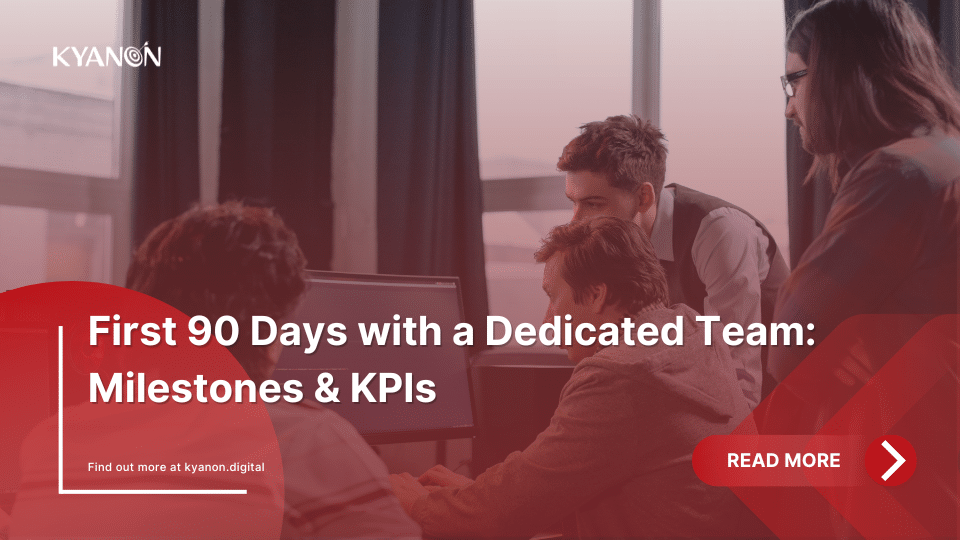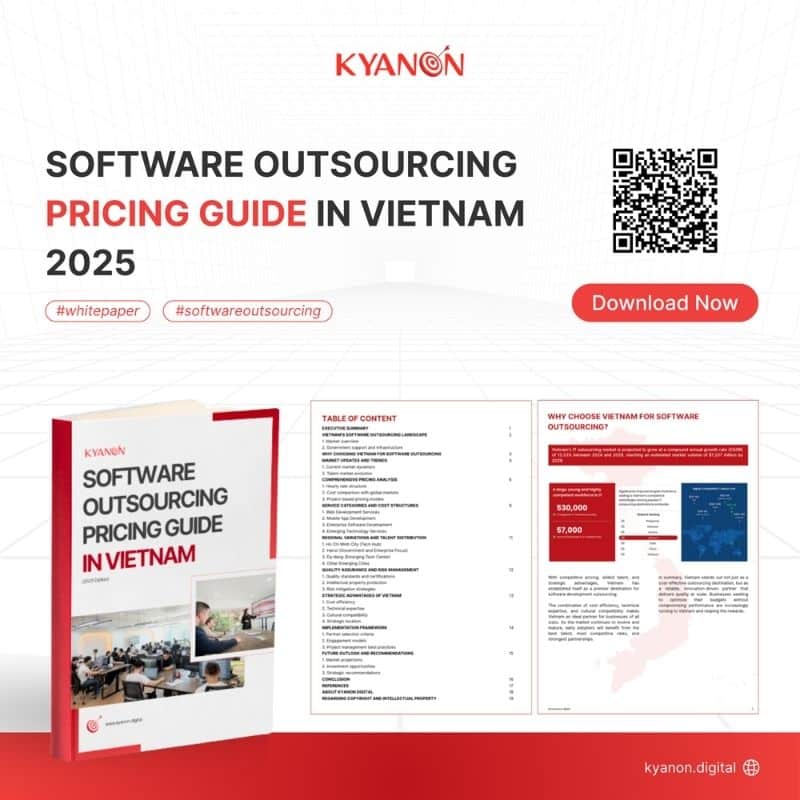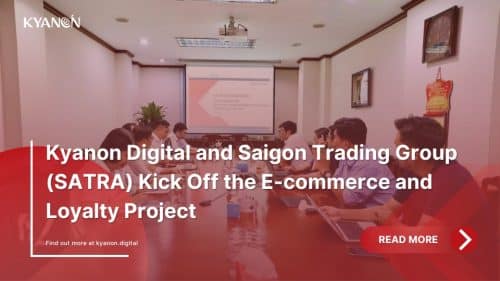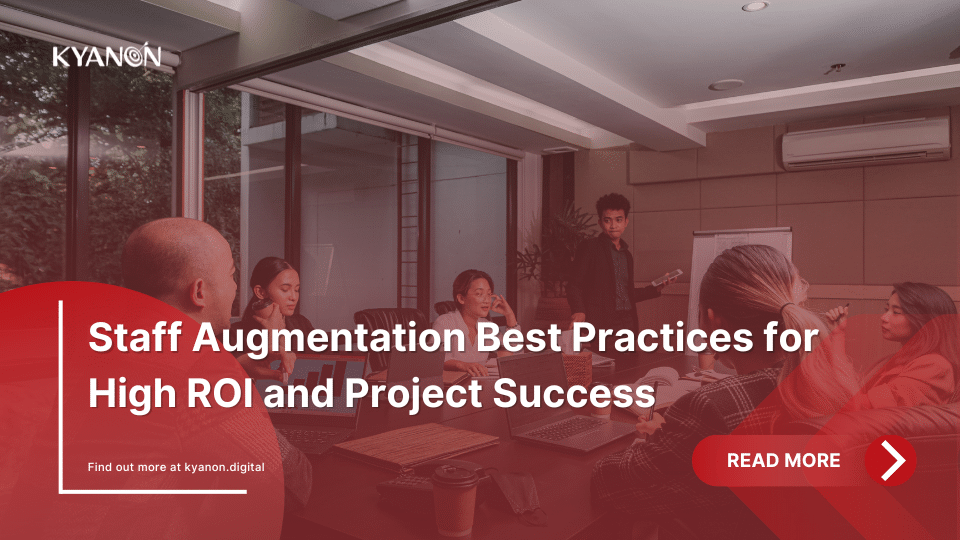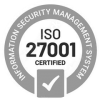Introduction: Why the First 90 Days Matter
The decision to hire a dedicated development team isn’t just another business transaction, it’s a strategic investment that can dramatically accelerate your digital initiatives. Yet our data at Kyanon Digital reveals a stark reality: the trajectory of success is largely determined within the first 90 days. 86% of project failures are caused by a lack of clear goals and poor communication within the first few weeks. (Project Management Institute)
What makes this initial period so critical? Some reports shows that the foundations established during this time: trust, communication patterns, technical alignment, and operational momentum, directly correlate with long-term ROI. According to a report by the Brandon Hall Group, companies with a structured onboarding process improve new hire retention by 82% and employee productivity by over 70%.
When you invest in dedicated hiring solutions, you’re not just acquiring development capacity, you’re integrating a specialized extension of your organization. This guide distills our decade of experience in building high-performing dedicated teams into actionable insights and metrics that will transform how you manage this critical transition period.
Further reading:
- 7 Key Roles In Every Dedicated Software Development Team
- 5 Best Practices For Having Success With A Dedicated Software Development Team
- Hire a Dedicated Development Team in Vietnam: The Guide for Australian, US, and EU Clients
Day 0 – 14: Discovery & Integration Phase
The initial two weeks represent your highest-leverage opportunity to set your dedicated team up for success. The survey from Gallup revealed that only 12% of newly hired employees believe their organization provides a strong onboarding experience. This presents a huge opportunity, as employees who benefit from comprehensive onboarding are 2.6 times more likely to feel satisfied with their jobs.This phase isn’t just about logistics, it’s about creating the neural pathways of your extended team.
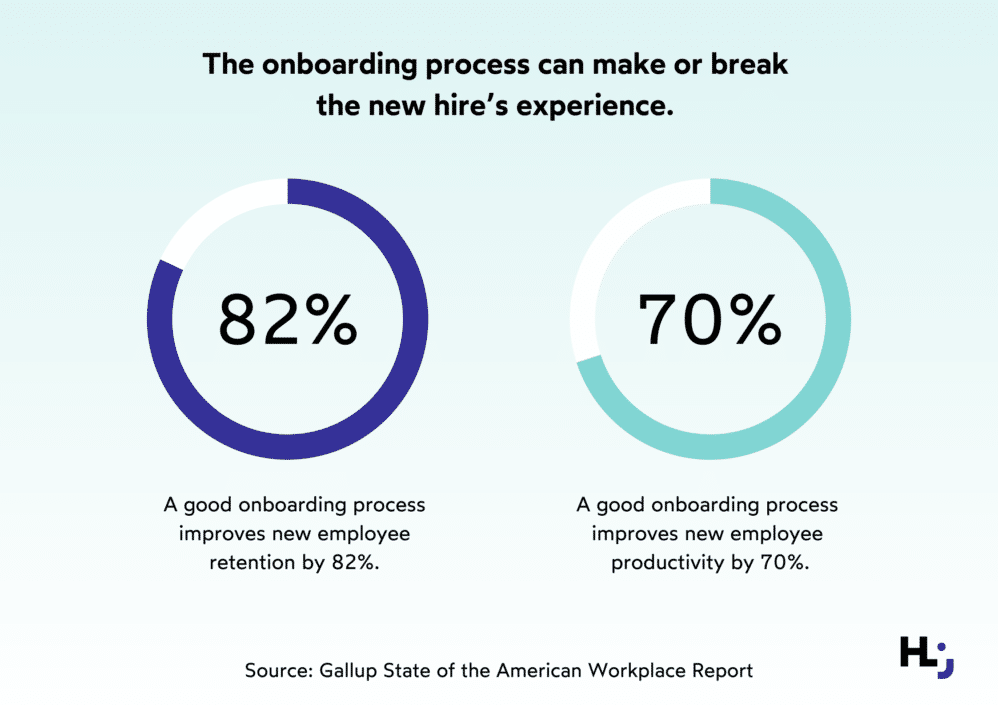
Milestones
- Immersive Knowledge Transfer: Beyond standard onboarding, immersive domain transfer including business context, user personas, and strategic objectives
- Technical Environment Mastery: Full development stack configured with documented architecture maps and dependency relationships
- Communication Infrastructure: Established channels, response protocols, and visibility frameworks tailored to your organization
- Alignment Workshop: Interactive session mapping business goals to development priorities with key stakeholders
- Validated Backlog Creation: Initial work items qualified against business value metrics and technical feasibility
KPIs
- Knowledge Absorption Index: Structured assessment showing comprehension of your business domain (industry leaders achieve 85%+ by day 14)
- Environment Readiness Score: Composite metric of development, testing, and deployment pipeline readiness (target: 100% by day 10)
- First Value Delivery: Time to first meaningful contribution, even small, that impacts your business (top-performing teams achieve this by day 12)
- Cross-functional Engagement: Number of meaningful interactions with different departments in your organization (target: minimum 5 departments)
- Decision Velocity: Average time from question raised to resolution provided (high-performing partnerships maintain under 3 hours)
Transform your ideas into reality with our services. Get started today!
Our team will contact you within 24 hours.
Day 15 – 30: Sprint Alignment & Process Calibration
With foundations established, this phase transforms your dedicated team from “getting ready to deliver” to “delivering with increasing momentum.” This period often determines whether your team will merely execute tasks or truly drive innovation.
Milestones
- Understanding Your Development Process: A clear analysis of your development process to find areas for improvement
- Measuring Team’s Working Speed: Measuring the team’s average work speed across different types of tasks
- Delivering the First Completed Feature Set: A complete set of features that meets quality standards and is ready for review by stakeholders
- Setting Up a Feedback Process: A structured way to collect, prioritize, and apply input from stakeholders
- Identifying and Preventing Risks Early: Identifying and addressing technical and business risks early to avoid problems later
KPIs
- Sprint Completion Accuracy: The percentage of planned work that is actually completed during a sprint (high-performing teams reach 92%+ by the end of the month)
- Time to Finish Tasks by Type: How long it takes to complete different types of tasks, compared to industry benchmarks
- Balance Between New Features and Improvements: The balance between adding new features and improving the system’s architecture (ideal balance depends on the phase of the project)
- Speed of Applying Feedback: How quickly useful feedback is turned into development tasks (goal: high-priority feedback addressed within 1 sprint)
- Quality on First Try: The percentage of work that meets all quality requirements the first time without needing rework (goal: 90%+ by day 30)
Day 31 – 60: Performance Visibility & Midpoint Review
The second month is where superior dedicated teams separate themselves from average ones. This phase focuses on transparency, accountability, and the shift from reactive to proactive contribution. Highly successful agile transformations typically delivered around 30 percent gains in efficiency, customer satisfaction, employee engagement, and operational performance; made the organization five to ten times faster; and turbocharged innovation. (McKinsey & Company)
Milestones
- Performance Dashboard Implementation: Real-time visualization of technical and business metrics with automated alerts
- Cross-functional Feature Delivery: Completion of end-to-end functionality requiring coordination across multiple disciplines
- Midpoint Strategic Alignment: Comprehensive review of business objectives against delivery progress with course corrections
- Knowledge Amplification Program: Structured knowledge sharing expanding from dedicated team to your internal staff
- Continuous Improvement Flywheel: Self-sustaining process optimization rhythm with measurable efficiency gains
KPIs
- Business Value Delivery Rate: Measured contribution to defined business objectives per sprint (target: consistent upward trend)
- Architecture Quality Index: Composite metric of code quality, scalability factors, and technical debt measurements (target: exceeding organizational standards)
- Innovation Contribution Frequency: Rate of viable improvement suggestions from team members (high-performing teams average 3-5 per sprint)
- Knowledge Dissemination Effectiveness: Measured improvement in organizational capability resulting from dedicated team expertise
- Impediment Resolution Efficiency: Average time from obstacle identification to complete resolution (target: <6 hours for critical issues)
Configure your performance dashboard to show not just technical metrics, but also business impact measures such as revenue influence, cost reduction, or customer experience improvements.
Day 61 – 90: Strategic Acceleration & Ownership
The final phase of the initial period transforms your dedicated team from technical executors to strategic partners. This is where your investment in dedicated hiring solutions should begin returning exponential value through enhanced capabilities and organizational leverage.
Milestones
- Autonomous Value Stream Ownership: Team fully empowered to make decisions within defined strategic boundaries
- Predictive Quality Assurance: Advanced testing strategies preventing defects rather than merely detecting them
- Strategic Roadmap Co-creation: Active contribution to product evolution based on technical insights and market understanding
- Innovation Incubation: Dedicated exploration time yielding tangible prototypes of potential future enhancements
- Operational Excellence Framework: Documented, repeatable processes ensuring consistent quality and efficiency
KPIs
- Autonomy Effectiveness Ratio: Business value delivered per unit of management oversight (target: steady increase)
- Strategic Initiative Advancement: Measured progress on long-term business objectives (target: ahead of baseline projections)
- Technical Innovation Impact: Quantifiable benefits from team-initiated improvements (leading teams generate 15%+ efficiency gains)
- Knowledge Equity Growth: Increase in organizational intellectual property and capabilities (measured through capability assessments)
- Client Enablement Score: Assessment of how effectively the team is advancing your strategic objectives (target: 9/10 by day 90)
Teams that achieve high autonomy effectiveness scores by day 90 are much more likely to drive transformational business outcomes over the long term. This is why we emphasize self-sufficiency as a core development target.
Success Signals to Watch For
Based on our analysis of our dedicated teams, these indicators by day 90 correlate most strongly with exceptional long-term outcomes.
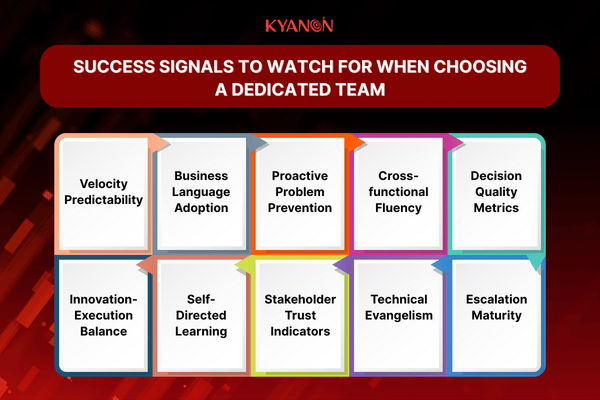
- Velocity Predictability: Sprint commitments consistently achieved within 10% variance for at least 4 consecutive iterations
- Business Language Adoption: Team members discussing features in terms of user benefits and business outcomes rather than technical specifications
- Proactive Problem Prevention: Issues identified and addressed before they impact delivery or quality (prevention ratio > detection ratio)
- Cross-functional Fluency: Development team demonstrating understanding of adjacent disciplines including design, marketing, and business strategy
- Innovation-Execution Balance: Healthy ratio of exploratory work to feature delivery without sacrificing commitments
- Self-Directed Learning: Team proactively acquiring new skills and knowledge aligned with evolving project needs
- Stakeholder Trust Indicators: Business owners bringing new opportunities to the team without prompting
- Technical Evangelism: Team members becoming internal advocates for quality practices across your organization
- Decision Quality Metrics: High success rate of technical and architectural decisions when measured against outcomes
- Escalation Maturity: Issues raised with potential solutions rather than merely as problems
Red Flags Not to Ignore
Our experience with hundreds of dedicated development teams has identified these critical warning signs that require intervention.
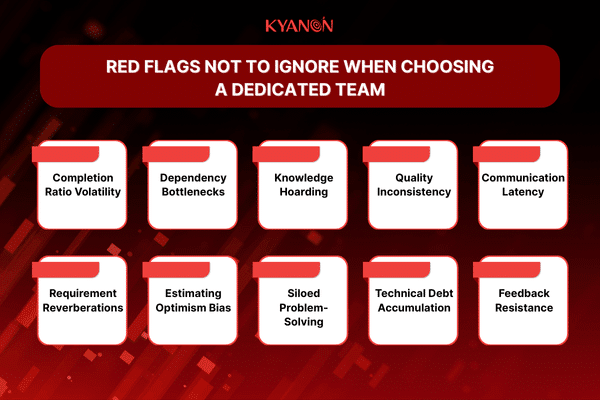
- Completion Ratio Volatility: Wide swings in sprint completion percentages (>25% variance) across consecutive iterations
- Dependency Bottlenecks: Recurring delays attributed to external factors without mitigation strategies
- Knowledge Hoarding: Information concentrated in specific team members with no dissemination plan
- Quality Inconsistency: Unpredictable defect rates or test coverage fluctuations across similar work items
- Communication Latency: Response times exceeding agreed SLAs without justification
- Requirement Reverberations: Same clarifications repeatedly requested across multiple work items
- Estimating Optimism Bias: Consistent underestimation of effort despite historical data
- Siloed Problem-Solving: Issues addressed without cross-functional collaboration
- Technical Debt Accumulation: Declining code quality metrics without corresponding remediation plans
- Feedback Resistance: Defensive responses to constructive input rather than adaptation
When you detect these signals, our recommended approach is to implement a two-week reset period focusing exclusively on process recalibration rather than feature delivery. This investment prevents compounding issues that typically require 4x longer to address later.
Best Practices for Clients in the First 90 Days
When you hire a dedicated software development team, your success isn’t just based on their capabilities, it’s shaped by how you engage with them in the first 90 days. These best practices help organizations move beyond basic delivery to unlock the full value of dedicated hiring solutions.
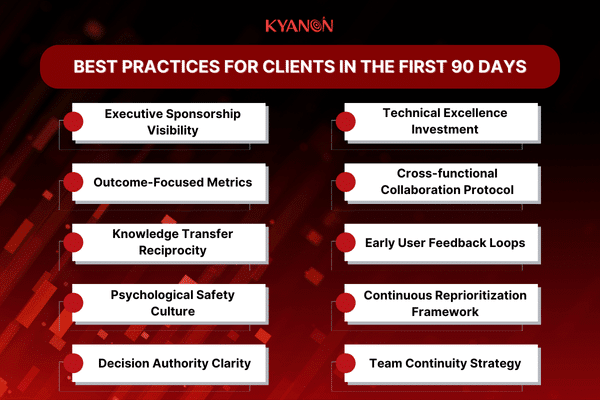
1. Executive Sponsorship Visibility
Senior leaders should maintain regular engagement with the dedicated team. When leadership shows consistent support, it communicates that the team is a strategic partner, not just an external resource.
2. Outcome-Focused Metrics
Set performance goals that reflect business impact, not just velocity or hours billed. By aligning your dedicated team with KPIs such as user adoption or cost reduction, you ensure their work contributes directly to your bottom line.
3. Knowledge Transfer Reciprocity
When you hire a dedicated development team, don’t just expect them to learn your business. Foster a two-way exchange where your internal team also learns new technical insights, methodologies, or tools introduced by the external experts.
4. Psychological Safety Culture
Build a culture of openness where your dedicated team feels safe to ask questions, flag risks, or propose improvements. This accelerates problem-solving and increases innovation potential.
5. Decision Authority Clarity
Clearly define decision rights across both internal stakeholders and your dedicated team. Understanding who can approve features, change priorities, or resolve blockers prevents confusion and project delays.
6. Technical Excellence Investment
Make time for quality. A smart move when you hire a dedicated software development team is to allocate bandwidth for automation, code refactoring, and improving architecture, not just feature delivery.
7. Cross-functional Collaboration Protocol
Create structured workflows to help your dedicated team collaborate smoothly with other business units like product, security, or support. This bridges silos and enables more efficient cross-team delivery.
8. Early User Feedback Loops
Expose your dedicated team to real customer insights early. Whether through surveys, live sessions, or NPS data, this gives them the context to build solutions that truly meet user needs.
9. Continuous Reprioritization Framework
The ability to quickly pivot is key. Set up frequent backlog reviews or sprint planning sessions so your dedicated team can adjust based on new priorities or market feedback.
10. Team Continuity Strategy
Expect changes and plan accordingly. One of the strengths of dedicated hiring solutions is continuity, ensure that documentation, onboarding playbooks, and shadowing processes are in place to retain momentum over time.
Sample 90-Day Dedicated Team Scorecard
A well-structured scorecard helps track progress, align goals, and identify early risks in a dedicated team setup. Below is a sample 90-day scorecard framework tailored to assess both performance and collaboration effectiveness.
| Phase | Timelines | Milestones | KPIs |
| Discovery & Integration Phase | Day 0–14 | – Immersive knowledge transfer
– Technical environment setup – Communication protocols defined – Alignment workshop – Validated backlog creation |
– Knowledge Absorption Index
– Environment Readiness Score – First Value Delivery – Cross-functional Engagement – Decision Velocity |
| Sprint Alignment & Process Calibration | Day 15–30 | – Value stream mapping
– Velocity baseline established – First client-ready increment – Feedback integration protocol – Proactive risk mitigation |
– Sprint Predictability Index
– Cycle Time by Work Type – Technical Debt Ratio – Stakeholder Feedback Implementation – First-Time Quality Rate |
| Performance Visibility & Midpoint Review | Day 31–60 | – Performance dashboard live
– Cross-functional feature delivery – Midpoint strategy check-in – Knowledge amplification – Continuous improvement rhythm |
– Business Value Delivery Rate
– Architecture Quality Index – Innovation Contribution Frequency – Knowledge Dissemination Effectiveness – Impediment Resolution Efficiency |
| Strategic Acceleration & Ownership | Day 61–90 | – Value stream ownership
– Predictive QA implemented – Roadmap co-creation – Innovation incubation – Operational excellence framework |
– Autonomy Effectiveness Ratio
– Strategic Initiative Advancement – Technical Innovation Impact – Knowledge Equity Growth – Client Enablement Score |
This scorecard not only tracks operational effectiveness but also measures how well your dedicated team contributes to your broader strategic goals. To unlock the full potential of a dedicated team, partner with a reliable tech company like Kyanon Digital, where proven processes, measurable KPIs, and strategic alignment drive real business outcomes.
Conclusion: Transform Your Dedicated Team from Cost Center to Innovation Engine
The first 90 days with your dedicated development team establish more than just working patterns, they determine whether your investment will yield merely adequate delivery or true competitive advantage. By implementing the structured approach and metrics outlined in this guide, you position your organization to realize the full potential of your dedicated team investment.
At Kyanon Digital, our dedicated hiring solutions are engineered based on these proven principles, with onboarding processes specifically designed to accelerate time-to-value. Our clients typically see dedicated teams reaching peak productivity faster than industry averages, translating directly to accelerated product development and market advantage.
Our experts will analyze your current or planned dedicated team approach and provide a customized roadmap for optimization, including:
- Personalized 90-day implementation plan
- Custom KPI dashboard configured for your business objectives
- Risk mitigation strategy based on your specific technology stack
- Executive briefing on dedicated team performance optimization

Why Partner with Kyanon Digital?
We’re a Tech Partner, Not a Recruiter
We build your team strategically, aligning talents with your software vision and roadmap, not just job requirements. With ongoing upskilling and expert support from our Center of Excellence, your talent stays ahead of challenges and delivers results.
Comprehensive Talent Ecosystem
Kyanon Digital talent ecosystem encompasses over 50,000 technology professionals
- Internal Talent Core: 300+ professionals
- K-Fresh Program: Nurturing Future Digital Leaders from 18 Universities in Vietnam
- External Talent Network: 15,000+ premium candidates
- Partner Network: 1,000+ trusted partners
Your One-Stop Talents Impact Solution
We manage from talent acquisition to HR management for your tech workforce, freeing your team to focus on core business and innovation.
Transform your dedicated team from a development resource into a strategic advantage. Contact Kyanon Digital today and discover why leading organizations trust us as their dedicated hiring solution partner.
Key takeaways
- A structured first 90 days is critical to unlocking the full potential of your dedicated team.
- Effective onboarding directly impacts speed, quality, and team satisfaction.
- Clear KPIs and phase-based milestones keep the team aligned with your business goals.
- High-performing teams evolve into strategic partners, not just task executors.
- Real-time performance tracking ensures transparency and continuous improvement.
References
- My project is failing, it is not my fault, Project Management Institute
- The impact of agility: How to shape your organization to compete, McKinsey & Company
- How do onboarding management systems impact timetoproductivity for new hires?, Vorecol
- Why the Onboarding Experience Is Key for Retention, Gallup
Get the Vietnam Software Outsourcing Pricing Guide 2025
Your shortcut to Vietnam’s outsourcing costs and key market insights.

Why work with Kyanon Digital?
- Expertise Trusted by Fortune 500 Clients
With deep experience serving Fortune 500 companies, we deliver tailored, high-impact solutions that meet the unique demands of global enterprises. - A World-Class IT Team
Our 500+ IT experts—spanning consulting, project management, technical architecture, software engineering, QA, DevOps, and AI/ML—are committed to excellence in every project. - Quality at the Core
Certified under ISO 9001, our quality-first approach guarantees precision, reliability, and continuous improvement. - Uncompromising Security
ISO 27001-certified, we integrate robust security into every process, leveraging advanced technologies to protect your data against evolving threats.

